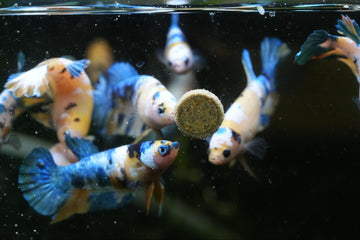A Simple Guide on How to Change Betta Fish Water

Contents
- 1- Why Do You Need to Change Betta Fish Water
- 2- How Often Should You Change Betta Fish Water?
- 3- Preparation Before Changing Water
-
4- Step-by-step Guide to Changing Your Betta Fish Water
- 4.1- Step 1: Prepare the New Water
- 4.2- Step 2: Turn Off Equipment
- 4.3- Step 3: Remove the Betta (Optional)
- 4.4- Step 4: Siphon Out the Old Water
- 4.5- Step 5: Inspect and Clean the Tank
- 4.6- Step 6: Add the New Water
- 4.7- Step 7: Monitor the Water Parameters
- 4.8- Step 8: Routine Maintenance and Tips
- 5- How Often Should You Change Betta Fish Water?
- 6- Common Mistakes to Avoid While Cleaning Your Betta Tank
- 7- Choosing the Best Betta from Tropicflow
Keeping your betta fish happy and healthy starts with clean water, and changing it regularly is one of the most important things you can do.
In this easy-to-follow guide, we’ll show you how to change your betta fish's water so they can thrive in a clean environment.
Whether you’re a seasoned fish keeper or just starting out, knowing how to do this properly is key to your betta’s health and happiness.
We’ll cover the best ways to change the water, what tools you’ll need, and tips to make the process as stress-free as possible for your fish.
Let’s get started and learn how to create a sparkling home for your beloved betta!
Why Do You Need to Change Betta Fish Water
Betta fish are sensitive little guys, and the water they swim in is super important for their health.
Over time, things like fish waste, leftover food, and bits of plants can build up in their tank. This buildup can create harmful toxins like ammonia, nitrites, and nitrates, which can stress your betta and make them sick if you don't take care of it.
These toxins won’t just disappear on their own. Even if you have a filter, you still need to change the water regularly to keep things safe for your fish. Think of it like taking out the trash—if you let it pile up, it can become a real problem. The same goes for your betta's tank.

When you change the water, you're not only removing waste but also adding back essential minerals and nutrients that your betta needs to thrive. Fresh water helps boost oxygen levels, which is really important for a fish that breathes through gills and sometimes takes air from the surface.
Regular water changes also help keep the water conditions stable. This stability is key to preventing common problems like fin rot and ammonia poisoning, which can be serious if not addressed.
By maintaining a clean and balanced environment, you’re giving your betta the best chance for a long and healthy life.
How Often Should You Change Betta Fish Water?
The frequency of water changes depends on the size of the tank and whether it is filtered:
- Small, unfiltered tanks (1-3 gallons): In these setups, water tends to get dirty fast. You should perform a partial water change of about 25-50% every 2-3 days and a complete water change once a week.
- Filtered tanks (5+ gallons): With proper filtration, you can reduce the frequency of water changes to about 20-30% every week. The filter helps break down waste, but it doesn’t eliminate the need for manual cleaning.
Preparation Before Changing Water
Before you start the water change, gather all necessary materials:
- A clean bucket (dedicated to aquarium use only)
- A siphon or aquarium vacuum for removing water
- A water conditioner to neutralize harmful chemicals in tap water
- A thermometer to ensure water temperature consistency
- A net for safely handling your betta (optional for larger changes)
- A gravel vacuum for cleaning the substrate
Step-by-step Guide to Changing Your Betta Fish Water
Step 1: Prepare the New Water
It’s important to have the replacement water ready before you start removing the old water. Use tap water treated with a water conditioner to neutralize chlorine and chloramines. These chemicals are present in most municipal water supplies and can be toxic to fish if not removed.
Additionally, make sure the temperature of the new water matches the existing tank water to avoid shocking your fish. Betta fish prefer water temperatures between 76-82°F (24-28°C), so use a thermometer to check both the tank water and the new water.
Step 2: Turn Off Equipment
Turn off any tank equipment such as filters, heaters, and air pumps before beginning the water change. This will prevent damage to the equipment and ensure your safety while working in the tank.
Step 3: Remove the Betta (Optional)
You don’t necessarily have to remove your betta from the tank during a partial water change. In fact, keeping them in the tank can minimize stress. However, if you plan to remove a large percentage of the water, you might want to transfer your betta to a smaller container temporarily.
If you choose to move your betta:
- Fill a small container (such as a plastic cup) with some of the tank water.
- Gently scoop your betta into the cup, being careful not to trap their fins.
- Cover the container lightly with a breathable cover to prevent them from jumping out.
Removing your betta can reduce stress during a more extensive cleaning, but it’s important to handle them carefully to avoid injury.

Step 4: Siphon Out the Old Water
Now, it’s time to remove the old water. Place the siphon or gravel vacuum into the tank and begin siphoning water into a bucket.
If you have gravel or another substrate at the bottom of your tank, use the siphon to clean it by gently pressing the vacuum into the substrate. This will help remove uneaten food, waste, and debris that have settled at the bottom.
Aim to remove about 20-30% of the tank’s water during a regular water change. If the tank is particularly dirty or if it’s been a while since the last change, you might need to remove a bit more. However, avoid changing more than 50% of the water at once, as this can be stressful for your betta.
While siphoning, take care not to disturb any decorations or plants more than necessary. Bettas appreciate a stable environment, and moving things around too much can cause stress.
Step 5: Inspect and Clean the Tank
With some of the water removed, it’s a good time to inspect the tank for any signs of problems.
Check for algae buildup on the glass, decorations, and plants. If you notice algae, gently scrub it off with an algae scraper or pad.
Inspect the filter as well. If the filter media looks clogged or dirty, it may be time to rinse or replace it. However, never clean the filter media with tap water, as this can kill beneficial bacteria. Instead, rinse it in the bucket of tank water you just siphoned out.
Take a moment to also check for any uneaten food or debris that might be hiding in corners or under decorations. Removing these can help maintain water quality between changes.

Step 6: Add the New Water
Once the tank is clean, it’s time to add the new water. Slowly pour the conditioned, temperature-matched water into the tank. Pouring too quickly can stir up the substrate and stress your betta, so take your time.
If you removed your betta earlier, now is the time to gently return them to the tank. Use the net or cup to transfer them back, making sure they aren’t exposed to air for too long.
As you add the new water, watch your betta’s behavior. They should be curious and explore the newly refreshed tank.
If they seem stressed or are gasping at the surface, double-check the water temperature and parameters to ensure everything is within a safe range.
Step 7: Monitor the Water Parameters
After the water change, it’s a good idea to test the water parameters. Use a water test kit to check for ammonia, nitrites, nitrates, and pH levels. The ideal water conditions for bettas are:
- Ammonia: 0 ppm
- Nitrites: 0 ppm
- Nitrates: Below 20 ppm
- pH: 6.5-7.5
If any of these levels are outside the safe range, consider adjusting your maintenance routine or water source. Keeping a log of your water parameters can help you spot trends and address issues before they become serious.

Step 8: Routine Maintenance and Tips
Changing your betta’s water should be part of a regular maintenance routine. Aim to do partial water changes every week, or more frequently if the tank is smaller or heavily stocked. Regular water changes help prevent the buildup of toxins and keep the environment stable, reducing the risk of disease.
In addition to water changes, be sure to:
- Use an algae scraper to keep the glass clear.
- Regularly remove waste and debris from the bottom of the tank.
- Monthly rinsing in tank water helps maintain its effectiveness without killing beneficial bacteria.
- Ensure that heaters, filters, and lights are functioning correctly.
How Often Should You Change Betta Fish Water?
The frequency of water changes depends largely on the size of the tank and whether it is filtered:
- Small, unfiltered tanks (2-4 gallons): Water changes should be done weekly, with around 25-50% of the water replaced each time.
- Larger, filtered tanks (10-20 gallons or more): Partial water changes can be done every two weeks, replacing 20-25% of the water each time.
Regular testing of water parameters, such as pH, ammonia, nitrites, and nitrates, can help you determine the exact frequency needed for your tank.
Common Mistakes to Avoid While Cleaning Your Betta Tank
- Try not to do complete water changes, as they can disrupt the helpful bacteria that keep your tank healthy.
- Be careful not to give your betta too much food, as leftover bits can break down and make the water dirty.
- Always make sure the new water is the same temperature as the tank water to prevent shocking your betta.
- Skipping water tests can let problems like high ammonia or nitrite levels go unnoticed, so test regularly.
- While it’s good to clean algae off decorations, scrubbing too hard can remove beneficial bacteria, so be gentle.
- Never use soaps or chemicals to clean your tank or equipment, as even tiny amounts can be toxic to your betta.
- Pouring new water into the tank too fast can disturb the substrate and stress your fish, so always add it slowly and carefully.
Choosing the Best Betta from Tropicflow
If you’re looking to add a new betta to your collection, Tropicflow is a top choice for premium betta fish. Tropicflow offers a diverse selection of betta species, from the stunning Halfmoon and Plakat to rare Giant Bettas. We pride ourselves on providing only the healthiest fish, with a focus on vibrant colors and robust health.

Each fish at Tropicflow undergoes a two-day quarantine before shipping, ensuring it arrives in perfect condition.
Plus, with our 100% Live Arrival Guarantee, you can be confident that your new betta will be healthy and ready to thrive in its new home.
No comments











0 comments